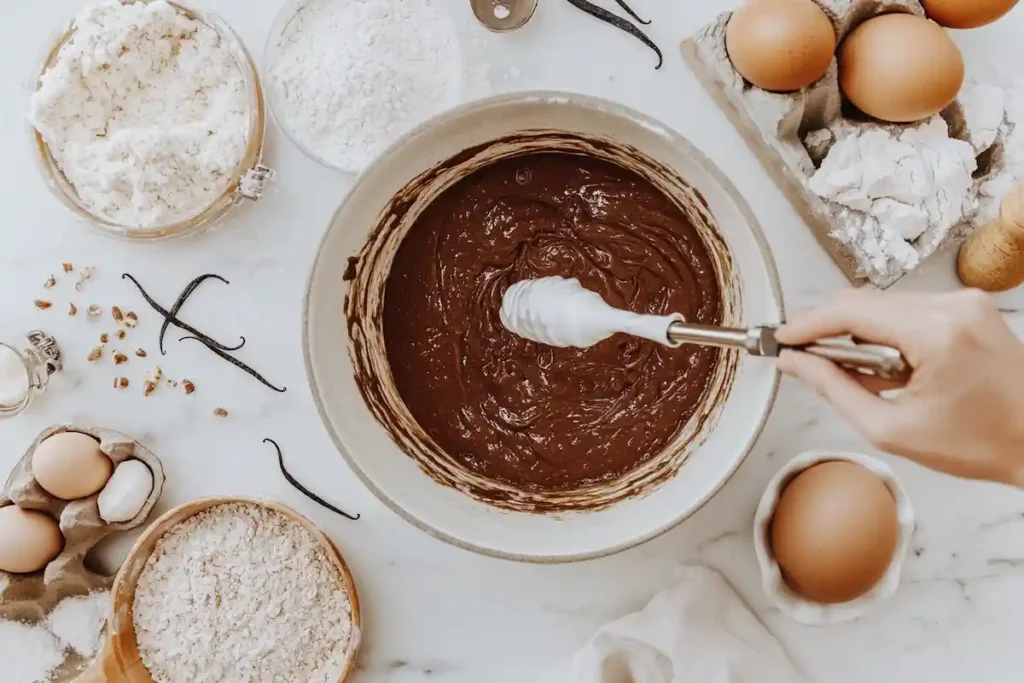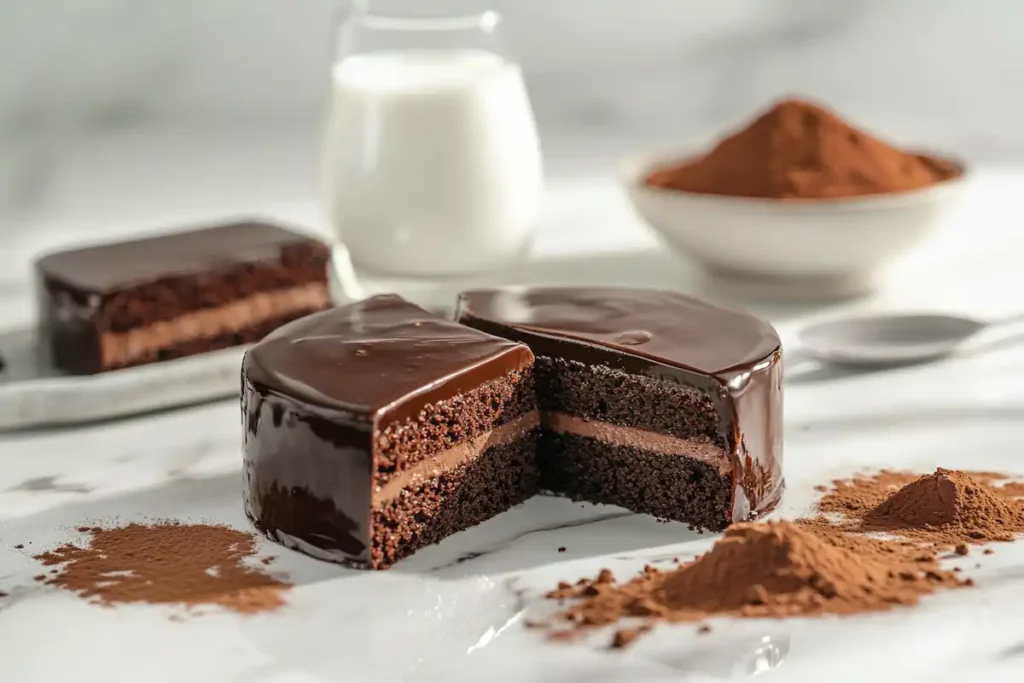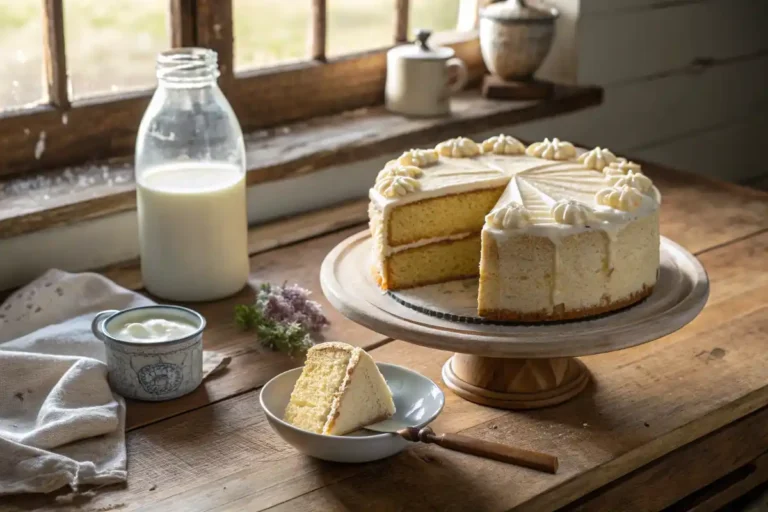When it comes to baking, the right ingredients make all the difference. One of the most common dilemmas home bakers face is substituting ingredients—particularly buttermilk. If you’ve ever wondered, “Can I use kefir instead of buttermilk in cake?” the answer lies in understanding the similarities and differences between these two ingredients. This article dives into the science of baking with kefir, explores its benefits as a buttermilk substitute, and provides helpful tips for perfect cakes every time. Let’s explore how kefir could be the versatile ingredient your recipes need.
1. Understanding Kefir and Buttermilk
What Is Kefir?
Kefir, a tangy, fermented drink, originates from the Caucasus and Eastern Europe. This probiotic-rich liquid is made by fermenting milk with kefir grains—a combination of bacteria and yeast that creates its characteristic fizz and tang. There are two main types of kefir:
- Dairy Kefir: Made with cow, goat, or sheep milk. It has a yogurt-like tang and a consistency similar to buttermilk.
- Water Kefir: A non-dairy alternative fermented with sugar water or coconut water, offering a milder flavor.
Besides its unique taste, kefir is packed with health benefits. It’s rich in calcium, protein, and gut-friendly probiotics, making it a favorite in health-conscious kitchens.
What Is Buttermilk?
Unlike kefir, buttermilk has a simpler story. Traditionally, it was the liquid left behind after churning butter. However, the buttermilk you find today is often cultured buttermilk—a blend of milk and lactic acid bacteria that mimics the tangy flavor of the traditional kind.
Buttermilk’s acidic nature gives it a tangy flavor and a thin yet creamy consistency. It’s often used in baked goods to:
- Activate baking soda for leavening.
- Add moisture and tenderness to cakes and breads.
Comparison of Kefir and Buttermilk
When comparing kefir and buttermilk, you’ll notice striking similarities and subtle differences:
- Taste and Texture: Both are tangy and creamy, though kefir has a slightly sharper flavor.
- Acidity Levels: Kefir is typically more acidic than buttermilk, which plays a role in how it interacts with baking soda.
- Health Benefits: While buttermilk provides calcium and protein, kefir outshines with its probiotic content, making it a nutritious alternative.
In baking, these similarities often mean you can swap one for the other, but slight adjustments may be necessary to ensure the perfect texture and flavor.
Nutritional Content of Kefir vs. Buttermilk (per 100g)
Here is a quick comparison of the nutritional values of kefir and buttermilk:
| Nutrient | Kefir (per 100g) | Buttermilk (per 100g) |
|---|---|---|
| Calories | 55 kcal | 40 kcal |
| Protein | 3.3 g | 3.1 g |
| Fat | 1.0 g | 0.9 g |
| Carbohydrates | 5.3 g | 4.8 g |
| Probiotics | High | Moderate |
| Calcium | 120 mg | 116 mg |
2. Why Kefir Can Replace Buttermilk in Cake Recipes
Similarities Between Kefir and Buttermilk
When it comes to baking, the similarities between kefir and buttermilk make them near-perfect substitutes. Both are tangy, creamy, and acidic, which are crucial traits for activating baking soda—a key leavening agent in many cake recipes. This means that substituting kefir for buttermilk won’t compromise the fluffiness of your cake.
Moreover, the consistencies of kefir and buttermilk are almost identical, ensuring your batter won’t become too runny or too thick. Whether it’s a classic vanilla cake or a rich chocolate creation, kefir’s properties ensure your baked goods remain tender and moist.
Benefits of Using Kefir Instead of Buttermilk
There are several compelling reasons to consider using kefir in your cakes. First, kefir adds more nutritional value to your recipe. Packed with probiotics, kefir offers gut health benefits that traditional buttermilk can’t match. So, your cake isn’t just delicious—it’s also a bit healthier.
Second, kefir’s robust tang can elevate the flavor profile of your cakes. Unlike buttermilk, kefir undergoes a longer fermentation process, which gives it a deeper, more pronounced flavor. This complexity can make your baked goods stand out.
Lastly, if you already have kefir in your fridge, you can skip the extra trip to the store for buttermilk. It’s a convenient and effective swap for most recipes.
Situations Where Kefir May Not Be Suitable
While kefir works wonderfully in most cakes, there are some scenarios where adjustments might be necessary. For example, if your recipe already includes strongly flavored ingredients, the pronounced tang of kefir might overpower subtler flavors. In these cases, using water kefir or diluting dairy kefir slightly can help.
Another consideration is kefir’s higher acidity. This may require you to tweak the proportions of baking soda or baking powder to avoid overly acidic results. Additionally, kefir’s slightly thinner texture might mean reducing the amount of other liquids in the recipe.
To see how kefir has been successfully incorporated into other recipes, you can check this detailed kefir sheet cake guide.
3. How to Substitute Kefir for Buttermilk in Cake Recipes
Exact Substitution Ratios
The most common question when replacing buttermilk is, “Can I use kefir instead of buttermilk in cake?” The good news is that you can substitute kefir for buttermilk at a 1:1 ratio. This means if your recipe calls for 1 cup of buttermilk, simply use 1 cup of kefir.
However, if your kefir is particularly thick, you might want to dilute it with a tablespoon or two of water or milk to match the consistency of buttermilk.
Tips for Using Kefir in Baking

For the best results, follow these tips when baking with kefir:
- Room Temperature Matters: Let your kefir come to room temperature before mixing it into your batter. Cold ingredients can lead to uneven baking.
- Mix with Dry Ingredients Last: To avoid over-activating the leavening agents, add kefir just before combining your wet and dry ingredients.
- Balance the Acidity: If the tang of kefir is too strong for your liking, a pinch of sugar can help balance the flavor.
Adjusting Recipes When Using Kefir
Sometimes, you’ll need to tweak your recipe slightly when using kefir. For example:
- For recipes that use acidic fruits (like lemon or orange): Reduce the amount of kefir slightly to avoid too much tang.
- To maintain the right liquid ratio: Adjust the quantities of other liquids or dry ingredients as needed.
Kefir is an excellent alternative to buttermilk, whether you’re aiming for fluffier pancakes, richer cakes, or healthier baked goods. Incorporating it into your recipes opens up endless possibilities while maintaining the integrity of your dishes.
Part 4: The Science of Baking with Kefir (350 Words)
How Kefir Affects Cake Texture
Baking is both an art and a science, and ingredients like kefir play a pivotal role in creating perfect textures. Kefir’s acidity reacts with baking soda or baking powder, releasing carbon dioxide, which makes cakes rise and develop a fluffy crumb. This reaction ensures that your cake turns out light and airy without collapsing.
Moreover, kefir’s creamy consistency helps retain moisture in the batter. The result? A cake that stays tender and moist even after hours of baking. If you’ve ever had a dry cake, kefir can be a game-changer, especially in recipes like spiced loaves or rich chocolate cakes.
How Kefir Enhances Flavor
One of the key reasons bakers love using kefir is its unique ability to deepen a cake’s flavor. Kefir’s tangy notes add complexity, balancing out the sweetness of the batter. This makes it especially well-suited for cakes that feature chocolate, citrus, or spice-heavy flavors.
Additionally, the fermentation process in kefir introduces subtle umami notes, which elevate the overall taste profile of your baked goods. Cakes made with kefir often have a richer, more satisfying taste compared to those made with plain milk or water.
Common Mistakes When Baking with Kefir
While kefir is a versatile substitute, mistakes can happen. Here are a few to watch out for:
- Over-Acidifying the Batter: Too much acidity can overpower the flavors or disrupt the chemical reactions with leavening agents. Stick to recommended proportions for the best results.
- Incorrect Liquid Balance: Kefir can be slightly thinner or thicker than buttermilk. Adjust other liquids in your recipe to maintain the correct consistency.
- Ignoring Room Temperature: Adding cold kefir to your batter can lead to uneven mixing and affect the cake’s rise.
For additional tips on using fermented ingredients in baking, check out what kefir does in baking.
5. Popular Cake Recipes Featuring Kefir
Classic Vanilla Kefir Cake Recipe
Vanilla cakes are a timeless favorite, and kefir can take this classic to the next level. The tang of kefir enhances the vanilla flavor, resulting in a cake that’s both light and richly flavored. To try this at home:
- Combine your wet ingredients, including kefir, and mix until smooth.
- Gradually fold in dry ingredients, ensuring the batter is lump-free.
- Bake at 350°F (175°C) for 30–35 minutes, or until a toothpick comes out clean.
For a touch of indulgence, serve with whipped cream or a dusting of powdered sugar.
Chocolate Cake with Kefir

Chocolate lovers, rejoice! Kefir enhances the rich, earthy flavors of cocoa, making it a fantastic choice for chocolate cakes. The acidity in kefir reacts with cocoa powder, intensifying its chocolatey goodness. Add in some coffee or espresso powder for an even deeper flavor profile. This cake pairs beautifully with a chocolate ganache or a light buttercream frosting.
Gluten-Free and Vegan Kefir Cake Options
For those with dietary restrictions, kefir can still work wonders. Many dairy-free kefir options, like coconut or almond-based kefirs, provide the same tangy effect without compromising flavor. Gluten-free flours, such as almond or oat flour, pair well with kefir, creating cakes that are moist and flavorful.
If you’re interested in experimenting further, explore kefir sheet cake recipes for more inspiration.
4. The Science of Baking with Kefir
How Kefir Affects Cake Texture
The question “Can I use kefir instead of buttermilk in cake?” often leads to a discussion about how these ingredients affect the final texture of baked goods. Kefir is a game-changer in baking due to its unique properties. The natural acidity in kefir interacts with baking soda, producing carbon dioxide bubbles that make cakes rise beautifully. This chemical reaction results in cakes that are soft, fluffy, and perfectly risen.
Moreover, kefir’s slightly thick consistency ensures the batter retains enough moisture. This means your cakes will stay moist and tender for days, a feature that’s especially valuable for recipes like sponge cakes or dense loaf cakes.
How Kefir Enhances Flavor
Kefir not only affects texture but also significantly improves flavor. Its fermentation process develops tangy and complex flavors that add depth to baked goods. When used in cakes, kefir balances the sweetness of the batter, enhancing flavors like chocolate, spices, or citrus.
Additionally, the mild umami notes from kefir create a satisfying richness that complements both simple and elaborate recipes. This subtle enhancement can make a plain vanilla or lemon cake taste more sophisticated, turning an everyday dessert into a showstopper.
Common Mistakes When Baking with Kefir
While kefir is an excellent substitute for buttermilk, there are a few pitfalls to avoid:
- Excess Acidity: If your recipe already has other acidic ingredients (like lemon juice or vinegar), the batter might become overly tangy. Adjust these elements when using kefir.
- Incorrect Liquid Ratios: Kefir can sometimes be thicker than buttermilk. If this affects the consistency of your batter, you may need to tweak other liquid components.
- Cold Ingredients: Using kefir straight from the fridge can hinder mixing and leavening. Let it come to room temperature for smoother blending.
For additional tips and insights into baking with kefir, explore recipes like kefir sheet cake for inspiration.
5. Popular Cake Recipes Featuring Kefir
Classic Vanilla Kefir Cake Recipe
Vanilla kefir cake is a simple yet elegant dessert that highlights kefir’s versatility. By substituting buttermilk with kefir, you enhance the vanilla flavor while achieving a moist and fluffy texture. Follow these easy steps:
- Mix kefir with sugar, eggs, and vanilla extract until smooth.
- Gradually add flour, baking soda, and a pinch of salt, blending gently.
- Bake at 350°F (175°C) for about 30–35 minutes, or until golden brown.
Serve it plain or with a dollop of whipped cream for a classic treat.
Chocolate Cake with Kefir
Chocolate cake gets a flavor boost when kefir is used as a buttermilk replacement. Kefir’s acidity intensifies the richness of cocoa powder, creating a decadent dessert. The added moisture from kefir also ensures that each bite is soft and velvety.
For a unique twist, try adding a hint of espresso powder to the batter—it pairs beautifully with kefir’s tangy undertones. This cake is perfect for birthdays or as a rich indulgence for chocolate lovers.
Gluten-Free and Vegan Kefir Cake Options
Kefir isn’t just for traditional cakes—it’s also ideal for gluten-free and vegan recipes. Many non-dairy kefirs, like almond or coconut-based varieties, work well in vegan baking. Combine them with gluten-free flour blends for a cake that’s light, flavorful, and inclusive.
If you’re experimenting with new recipes, check out kefir baking recipes for more creative ideas and techniques.
These recipes demonstrate just how versatile kefir can be in the kitchen. Whether you’re making classic cakes or trying something new, kefir offers a flavorful and functional alternative to buttermilk. Next, we’ll dive into frequently asked questions to help you master the art of baking with kefir!
6. FAQs About Using Kefir Instead of Buttermilk in Baking
Can I Use Kefir Instead of Buttermilk in Cake?
Absolutely! The simple answer is yes—you can use kefir instead of buttermilk in cake. Since both ingredients are acidic, they work similarly in activating baking soda, giving your cakes that light, fluffy texture. Keep in mind that kefir has a slightly stronger tang, so you might notice a more pronounced flavor, which could be a delightful twist in many recipes.
Are Kefir and Buttermilk Interchangeable?
While they are largely interchangeable, there are some slight differences between the two. Kefir tends to be more acidic and sometimes thicker than buttermilk. Therefore, when using kefir, you might need to adjust the quantity of other liquids in your recipe to maintain the right texture.
What Does Kefir Do in Baking?
Kefir brings more than just moisture and tang to your baked goods. Its acidity helps activate leavening agents like baking soda, ensuring your cakes rise beautifully. Additionally, it imparts a deeper flavor, making your cakes taste richer and more complex.
How to Make Buttermilk Out of Kefir?
If you’re out of buttermilk but have kefir on hand, you can dilute kefir with a little water to reduce its acidity. This can mimic the consistency and taste of buttermilk. Simply mix 3/4 cup of kefir with 1/4 cup of water, and you’ll have a suitable buttermilk replacement.
7. Conclusion: Kefir as a Versatile Baking Ingredient
Kefir has proven itself to be more than just a trendy health drink. Can I use kefir instead of buttermilk in cake? The answer is a resounding yes! Not only can kefir replace buttermilk in your cakes, but it also brings its own unique benefits to the table. Whether you’re looking for a tangier flavor, added moisture, or a nutritious boost, kefir is an excellent choice for most cake recipes.
As we’ve explored, kefir can improve texture, enhance flavor, and even make your cakes a little healthier with its probiotics and nutrients. While there are slight differences between kefir and buttermilk, the substitutions are easy to make with a few simple adjustments. Don’t be afraid to experiment with kefir in your next cake—whether it’s a classic vanilla, a decadent chocolate creation, or even a gluten-free option, kefir is a versatile and delicious ingredient.
So, next time you find yourself asking, “Can I use kefir instead of buttermilk in cake?”, just know that kefir is ready to elevate your baking game. Happy baking! For more delicious recipes, check out other great ideas on our site.

